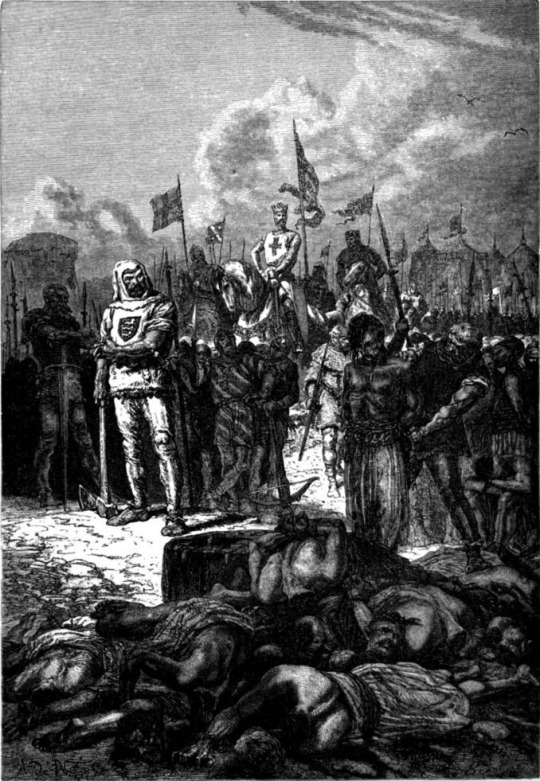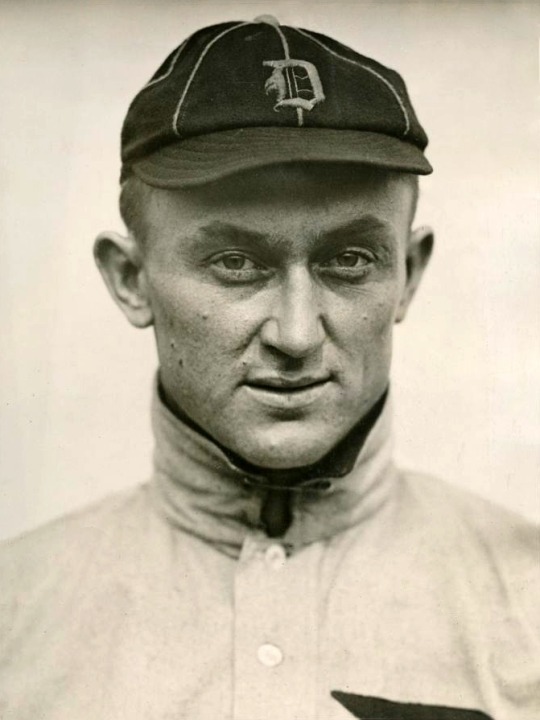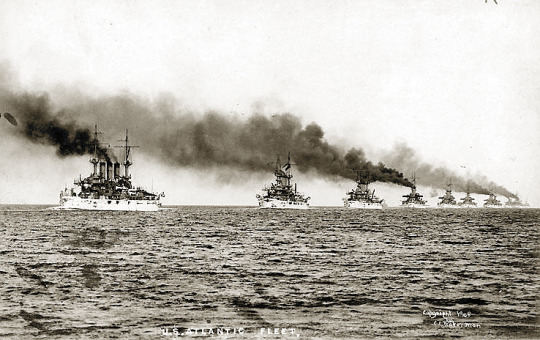#History Daily with Francis Chappell Black
Text

CRUSADER KING RICHARD I KILLS 2700 MUSLIM PRISONERS AFTER THE FALL OF ACRE
On August 20, 1191, the Massacre of Ayyadieh occurred during the Third Crusade after the fall of Acre when King Richard I had more than two thousand seven hundred Muslim Prisoners of war from the captured city beheaded in front of the Ayyubid armies of Sultan Saladin. Despite attacks by Muslim forces during the killings, the Christian Crusaders were able to retire in good order. Saladin subsequently ordered one thousand six hundred Crusader prisoners of war to be executed in retaliation.
Image: Massacre of the Saracen prisoners, ordered by King Richard the Lionheart by artist Alphonse de Neuville. (Wikimedia Commons.)
#HistoryDailywithFrancisChappellBlack
#history daily#Third Crusade#Massacre of Ayyadieh#Richard the Lionheart#Acre#History Daily with Francis Chappell Black
4 notes
·
View notes
Text

History Daily: 365 Fascinating Happenings Volume 1 & Volume 2
In this collection of stories, author Francis Chappell Black expertly guides you through some of the many fascinating narratives that make up the human experience. History Daily: 365 Fascinating Happenings Volume 1 (January – June) is a daily account of events that helped to shape our world, covering every day of the year. Our journey will showcase events that have enriched the human condition throughout all recorded history. Many of our tales will deal with unhappy occurrences starring some of history’s most unfortunate, infamous, and hopeless characters and events.
This collection of captivating stories highlights topics of history, war, science, culture, crime, the Old West, and more. This book offers new and compelling facts for each day of the year. You will be gripped by accounts of famous battles, groundbreaking scientific discoveries, moments from the history of crime, and uncelebrated details about cultural icons that have changed the course of history.
History Daily: 365 Fascinating Happenings Volume 1 (January – June)
History Daily: 365 Fascinating Happenings Volume 2 (July – December) (Due in September 2023)
Enjoy.
To order in the United States or the rest of the World please visit
History Daily: 365 Fascinating Happenings Volume 1: January – June: Chappell Black, Francis: 9780991855865: Amazon.com: Books
or in Canada
History Daily: 365 Fascinating Happenings Volume 1: January – June: Chappell Black, Francis: 9780991855865: Books – Amazon.ca
#HistoryDailywithFrancisChappellBlack
0 notes
Text

First Africans in Virginia. August 20, 1619.
On this day in history, twenty Africans, kidnapped by the Portuguese in Angola, make landfall in the British colony of Virginia and are subsequently purchased by the English colonists. The appearance of enslaved Africans in the New World marks the beginning of 250 years of slavery in North America.
For the rest of the story visit my website:
First Africans in Virginia. August 20, 1619. – History Daily With Francis Chappell Black (history-daily-with-francis-chappell-black.com)
#HistoryDailywithFrancisChappellBlack
#history daily#First Africans in America#Black History#colonial America#America's “original sin”#Jamestown#Virginia#1600s
3 notes
·
View notes
Text
SECOND BATTLE OF BULL RUN
On August 30, 1862, the Second Battle of Bull Run in Manassas, Virginia, ends with a Confederate victory over Federal forces.
The battle was the culmination of the Northern Virginia Campaign waged by Confederate Gen. Robert E. Lee's Army of Northern Virginia against Union Maj. Gen. John Pope's Army of Virginia, and a battle of much larger scale and numbers than the First Battle of Bull Run (or First Manassas) fought on July 21, 1861, on the same ground.
Following a wide-ranging flanking march, Confederate Maj. Gen. Thomas J. "Stonewall" Jackson captured the Union supply depot at Manassas Junction, threatening Pope's line of communications with Washington, D.C. Withdrawing a few miles to the northwest, Jackson took up strong concealed defensive positions on Stony Ridge and awaited the arrival of the wing of Lee's army commanded by Maj. Gen. James Longstreet. On August 28, 1862, Jackson attacked a Union column just east of Gainesville, at Brawner's Farm, resulting in a stalemate but successfully getting Pope's attention. On that same day, Longstreet broke through light Union resistance in the Battle of Thoroughfare Gap and approached the battlefield.
Pope became convinced that he had trapped Jackson and concentrated the bulk of his army against him. On August 29, Pope launched a series of assaults against Jackson's position along an unfinished railroad grade. The attacks were repulsed with heavy casualties on both sides. At noon, Longstreet arrived on the field from Thoroughfare Gap and took position on Jackson's right flank. On August 30, Pope renewed his attacks, seemingly unaware that Longstreet was on the field. When massed Confederate artillery devastated a Union assault by Maj. Gen. Fitz John Porter's V Corps, Longstreet's wing of 25,000 men in five divisions counterattacked in the largest simultaneous mass assault of the war. The Union left flank was crushed and the army was driven back to Bull Run. Only an effective Union rear guard action prevented a replay of the First Manassas defeat. Pope's retreat to Centreville was nonetheless precipitous.
Success in this battle emboldened Lee to initiate the ensuing Maryland Campaign.

Image: The Second Battle of Bull Run in Manassas, Virginia, fought August 29th and 30th, 1862.
History Daily With Francis Chappell Black – We offer captivating stories highlighting topics of history, war, science, crime, culture, the Old West, and more. Enjoy our 500 – 1000-word entries for every day of the year. (history-daily-with-francis-chappell-black.com)
2 notes
·
View notes
Text
YAMAMOTO TAKES COMMAND
On August 30, 1939, is appointed the Commander-in-Chief of the Japanese Navy
Yamamoto held several important posts in the Imperial Navy, and undertook many of its changes and reorganizations, especially its development of naval aviation. He was the commander-in-chief during the early years of the Pacific War and oversaw major engagements including the attack on Pearl Harbor and the Battle of Midway.
Yamamoto was killed in April 1943 after American code breakers identified his flight plans, enabling the United States Army Air Forces to shoot down his plane. His death was a major blow to Japanese military morale during World War II.
History Daily With Francis Chappell Black – We offer captivating stories highlighting topics of history, war, science, crime, culture, the Old West, and more. Enjoy our 500 – 1000-word entries for every day of the year. (history-daily-with-francis-chappell-black.com)
Image: Admiral Yamamoto, 1940. (Wikimedia Commons.)

1 note
·
View note
Text
TY COBB DEBUTS
On August 30, 1905, Detroit Tigers future Hall of Fame center fielder makes his MLB debut, doubling off Jack Chesbro in a 5-3 win over the New York Highlanders at Bennett Park, Detroit.
Cobb spent 22 seasons with the Detroit Tigers, the last six as the team's player-manager, and finished his career with the Philadelphia Athletics. He set 90 records during his career, several of which he still holds today.
He is widely considered as one of the greatest players of all time, but his legacy as an athlete has sometimes been overshadowed by his surly temperament, racism, and aggressive playing style.
History Daily With Francis Chappell Black – We offer captivating stories highlighting topics of history, war, science, crime, culture, the Old West, and more. Enjoy our 500 – 1000-word entries for every day of the year. (history-daily-with-francis-chappell-black.com)
Image: Ty Cobb with the Detroit Tigers in 1913. (Wikimedia Commons.)

1 note
·
View note
Text
BRITAIN'S FIRST FACTORY ACT BECOMES LAW ON AUGUST 29, 1833

Image: Children lining up for work outside a factory in the late nineteenth century
August 29, 1833 — The United Kingdom's historic first Factory Act became law today and was much needed.
Women and children faced a grueling workload and positively inhuman conditions, especially in the textile industry, as thousands of factories were built across the country to meet the burgeoning demands of the Industrial Revolution.
Apart from working incredibly long hours – often through the night – workers had to use dangerous machinery that could, and frequently did, cause serious injuries. And if an injured person caused production delays, they would be severely punished.
That applied in some cases even after the tired victim had been heavily fined or even, in the case of a child, beaten for arriving late for work.
Without any regulations to protect them, young children would be forced to work extremely long and dangerous hours, often because their impoverished parents needed money to feed the family.
Word began to spread about the appalling conditions in Britain's factories, and campaigns for improvement sprung up, leading to the 1833 legislation. It was opposed by Tory Members of Parliament and, of course, by the factory owners, who feared that any change might slow production and cut profits.
By today's standards, the reforms were modest and, in any case, applied only to the textile industry. The principal provisions of the Act declared that:
* Children under nine must not be employed in textile factories.
* Children between the ages of nine and thirteen must work at most eight hours and be provided an hour lunch break.
* Children between the ages of nine and thirteen could only be employed provided they also had two hours of education daily.
* Children under eighteen must not work after 8:30 p.m. and before 5:30 a.m.
* Children between the ages of fourteen and eighteen must work twelve hours a day or be given an hour's lunch break.
No rules were established to protect adult male workers, and only four factory inspectors were appointed to enforce the law nationwide!
A Factory Inspector's report around this time sheds light on some conditions. He wrote:
"I took the evidence from the mouths of the boys themselves. They stated to me that they commenced working on Friday morning, May 27, at 6 am and that, except for meal breaks and one hour at midnight extra, they continued working on Saturday evening, having been two days and a night thus engaged.
"Believing the case scarcely possible, I asked every boy the same questions, and from each received the same answers."
Examples of subsequent court records show that in 1862, John Jones, who ran a factory in Wales, faced a fine of £1 for "employing three young persons and one female after 6 pm."
Another Welsh factory owner, Samuel Harris, was accused in the same year of "employing two young persons and two children after 2 pm on a Saturday." The charges were dropped when he paid £1.14 shillings costs.
A new Factory Act in 1844 decreed that children aged eight to 13 could work six hours a day. Night work for women was banned.
In 1847, it was ruled that women and children under 18 could not work more than ten hours daily.
Then, the 1901 Factory Act raised the minimum age for workers to 12 and ruled that this would apply everywhere, not just the textile industry.
Despite the limitations of the 1833 Act, it did at least create the beginnings of a much-needed system of government control and offered, as one historian put it, "the first recognition that the common laborer needed state protection from the full might of unbridled capitalism."
History Daily With Francis Chappell Black – We offer captivating stories highlighting topics of history, war, science, crime, culture, the Old West, and more. Enjoy our 500 – 1000-word entries for every day of the year. (history-daily-with-francis-chappell-black.com)
1 note
·
View note
Text
King George's Rebellion Proclamation August 22, 1775

Image: King George III (Wikimedia Commons)
King George III officially proclaimed that the American colonies were in open rebellion and ordered his officials to suppress it. This was an insult to Americans who had just presented him with a petition of peace, known as the Olive Branch Petition. This document guaranteed the king that the Americans would remain his loyal subjects and had no desire for independence if their grievances were reasonably addressed. The American representatives Richard Penn and Arthur Lee gave the petition to the Secretary of State for the American colonies, Lord Dartmouth. Two days later, King George III issued his proclamation. This is one of the actions that convinced many wavering American colonists that the king genuinely sought to destroy their God-given rights and led to their Declaration of Independence the following year.
For more great historical content visit my website:
History Daily With Francis Chappell Black – We offer captivating stories highlighting topics of history, war, science, crime, culture, the Old West, and more. Enjoy our 500 – 1000-word entries for every day of the year. (history-daily-with-francis-chappell-black.com)
0 notes
Text

AMERICA’S GREAT WHITE FLEET ARRIVES IN SYDNEY, AUSTRALIA, TO A RAPTUROUS WELCOME; 221 AMERICAN SAILORS DESERT TO REMAIN IN AUSTRALIA.
The Great White Fleet was the name given for the group of United States Navy battleships that journeyed around the globe from December 16, 1907, to February 22, 1909, by order of President Theodore Roosevelt. It consisted of 16 battleships divided into two squadrons, along with various small escorts, and earned its moniker for the stark white paint on its hulls.
The fleet's primary mission was to make friendly courtesy visits to numerous countries while displaying new U.S. naval power to the world; Roosevelt sought to demonstrate growing American military prowess and blue-water naval capabilities. Another goal was to deter a threatened war with Japan amid growing tensions around 1907. The voyage helped familiarize the 14,500 officers and sailors with the logistical and planning needs for extended fleet action far from home.
After long neglecting the Navy, Congress started generous appropriations in the late 1880s. Beginning with just 90 small ships, over one-third of them wooden and obsolete, the Navy quickly added new steel fighting vessels. The fleet's capital ships were already obsolete compared to the British dreadnoughts in 1907. Nevertheless, it was by far the largest and most powerful fleet that had ever circled the globe; the mission was a success at home and in every country that was visited, including in Europe (which was visited only briefly).
Visit my website for more great historical content:
History Daily With Francis Chappell Black – We offer captivating stories highlighting topics of history, war, science, crime, culture, the Old West, and more. Enjoy our 500 – 1000-word entries for every day of the year. (history-daily-with-francis-chappell-black.com)
#HistoryDailywithFrancisChappellBlack
0 notes